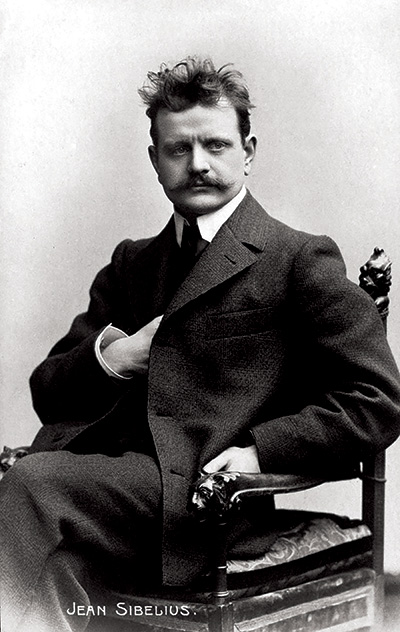Jean Sibelius

Born: December 8, 1865, Hämeenlinna, Finland
Died: September 20, 1957, Järvenpää, Finland
Symphony No. 1 in E Minor, Op. 39
- Composed: 1898-99
- Premiere: April 26, 1899 in Helsinki, conducted by the composer
- CSO Notable Performances:
- First: February 1910, Leopold Stokowski conducting
- Most Recent: January 2013, Yan Pascal Tortelier conducting
- Notable: March 22, 1993 at Carnegie Hall, Jesús López Cobos conducting
- Instrumentation: 2 flutes (incl. 2 piccolos), 2 oboes, 2 clarinets, 2 bassoons, 4 horns, 3 trumpets, 3 trombones, tuba, timpani, bass drum, crash cymbals, triangle, harp, strings
- Duration: approx. 38 minutes
By the time he was 34, when he finished his First Symphony, Sibelius was already a feted national hero. He came to maturity when his native Finland was searching for its national cultural and political identity after centuries of domination by Sweden and Russia, and his music gave vent to the aspirations of his countrymen at the time when the Czar’s representatives forbade inflammatory, patriotic words. To invest his works with a powerful nationalistic message, he turned for inspiration to the epic compilation of Finnish legends, the Kalevala. A series of stirring works based on those old stories preceded the First Symphony—En Saga and Kullervo (1892), Karelia Suite (1893) and Four Legends, which includes the haunting Swan of Tuonela (1893–1895). Finlandia was created in the same year—1899—as the E Minor Symphony. As early as 1897, Sibelius was granted an annual sustenance stipend from the Finnish Senate as recognition of his contribution to the life of the nation, so that he would be free to continue his creative work.
The First Symphony shows the influence both of Sibelius’ study of German music in Berlin and of the Russian dominance of Finland’s artistic life. Coming as it does in the last year of the Romantic century, the symphony looks back for its formal precedents to the orchestral works of the great masters of the German tradition, most notably Beethoven and Brahms. In melodic material, instrumentation and certain points of style, however, it turns further east, to the music of Borodin and, especially, Tchaikovsky, whose Sixth Symphony had been composed only six years before and performed in Helsinki in 1894 and 1897. Sibelius even told his wife, Aïno, of Tchaikovsky that “there is much in that man that I recognize in myself.” Against this Russo-German background, Sibelius placed his own strong musical personality in establishing himself as a symphonist with a work given to broad emotions and dramatic gestures in an expansive, Romantic mood.
The first movement is introduced by a bardic clarinet solo played above a timpani pedal point. (It is with such orchestral touches that Sibelius admitted trying to evoke the topography of his homeland, in this case the solitary reddish granite blocks jutting from the sea along Finland’s Baltic coast.) The sonata form proper is begun with the entry of the strings proclaiming the main theme, a typically Sibelian melody begun with a sustained note intensifying to a quick rhythmic flourish. A richly lyrical theme for violins and cellos follows. The second theme, related to the main theme in shape and rhythm, is given by the woodwinds. The development section utilizes the thematic material heard in the exposition, to which are added the stern brass chords so characteristic of Sibelius’ orchestral technique. The recapitulation includes most of the material from the exposition given in a heightened setting.
The Andante, warm and lyrical, opens with a nostalgic melody for violins and cellos. The central section is led by the horn choir playing a serene theme above the undulating accompaniment of the harp and strings. The long closing section elaborates the opening theme. The Scherzo, in traditional three-part form (A–B–A), comprises brassy, energetic outer sections surrounding a slow, sustained, contrasting trio. The finale begins with the solo clarinet melody that opened the symphony. Although the movement is marked “quasi una fantasia,” it follows sonata form, with an expressive second theme for strings in slower tempo. The functions of development and recapitulation are fused.
Of Sibelius’ first two symphonies, Milton Cross wrote, “[They] do not have subtlety of expression. They are Russian in their over-indulgence in dramatic statements, Slavic in their haunting, poignant melodies of peasant energy. They wear the heart on the sleeve. But what they lack in subtlety, they make up in dramatic effect. They have an overwhelming emotional impact.”
—Dr. Richard E. Rodda